Seto kingdom day
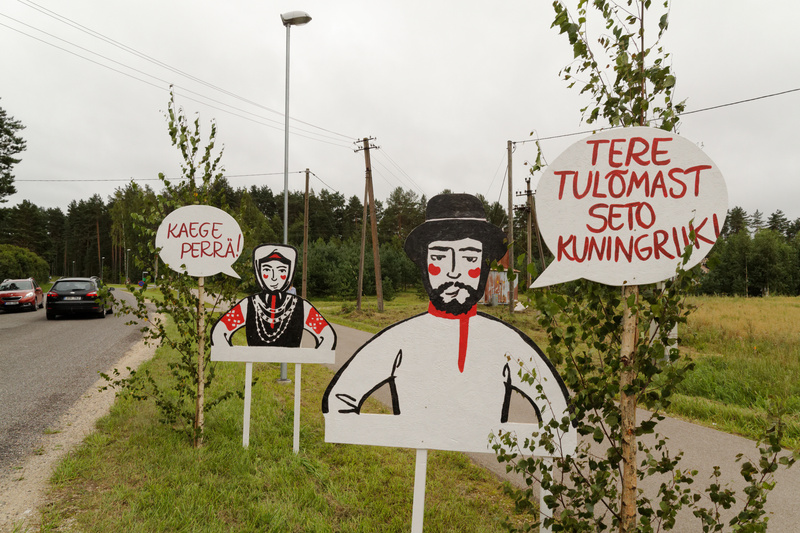
"Welcome to the Seto kingdom" |
In south-eastern Estonia, and across the border in Russia, lives the Seto people. They have kept many of their ancient traditions, and one of them is the traditional farmhouse brewing. Every summer they arrange Seto Kingdom Day, a kind of fair celebrating their traditions, and of course they serve traditional Seto koduõlu as part of it. So in the summer of 2016 we attended the festival to see what their beer was like.
When the Germanic crusader knights conquered Estonia in the 13th century the Estonians were forcibly converted to Christianity, but the Setos lived in an area controlled by the Republic of Novgorod, and so they remained pagans. Today they are mostly Russian orthodox, but their pagan folk religion is also still alive. Their language is usually considered a dialect of Estonian, but the Setos themselves want it recognized as a separate language. If you want to learn more I recommend this article from Deep Baltic.
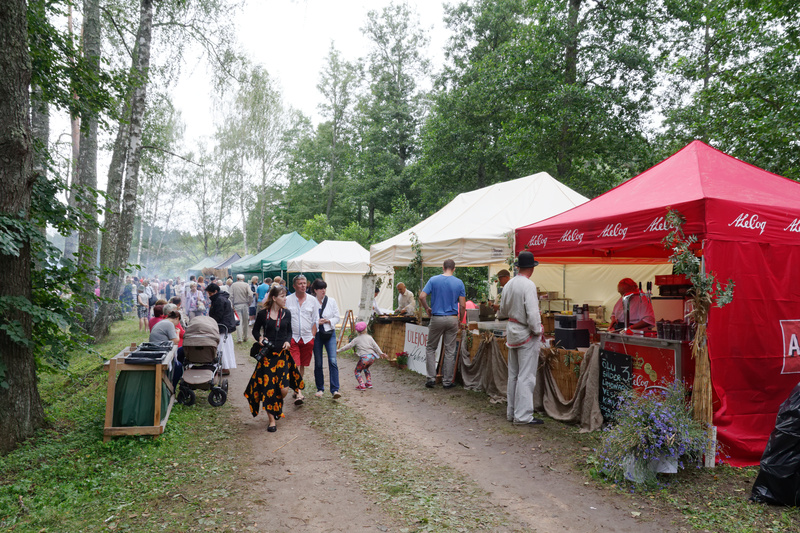
Stalls and visitors. Smoke from cooking fires in the background. |
Seto and Estonian are part of the Uralic family of languages, which does not have very many members in Europe. There is Hungarian, which is a distant relative, and then there is Finnish. The similarity with Finnish is sufficient that I could read the sign above, since "tervetuloa" is "welcome" in Finnish and "tere tulemast" in Estonian. The Sami languages also belong to this family, as do a number of indigenous languages in north-east European Russia. One of them, Komi-Permyak, will be coming up on the blog later.
At the festival there were dozens of stalls selling everything from beer and distilled spirits to cooked food, pickled cucumbers, and dried meats as well as handicrafts like felt hats and even honey. People were milling around in both Seto national costume and ordinary clothes. There was a big stage with performances of traditional Seto music and dances, and lots of announcements of people, but since it was all in Seto I understood very little of it.

Stall of Ain Raal, |
We quickly zoomed in on the stand in the photo above, belonging to Ain Raal, who had won the festival brewing competition four times. His beer was dark hazy reddish brown with no real head, just a thin ring of foam around the edge. It was sweet, and faintly acidic, with a juicy, spicy rye bread taste with raisiny notes, and of course almost completely flat. I couldn't pick up any hop character at all. It was a nice beer, and quite different from anything I'd had before.
Obviously, it was brewed from rye, but we couldn't really tell how. So we strolled around, looking for more examples. A pretty girl was serving a similar beer, brewed by her father. One guy was pouring the beer from white plastic buckets. And there was another three-time champion, also serving beer. Their beers were all pretty similar to Ain Raal's.
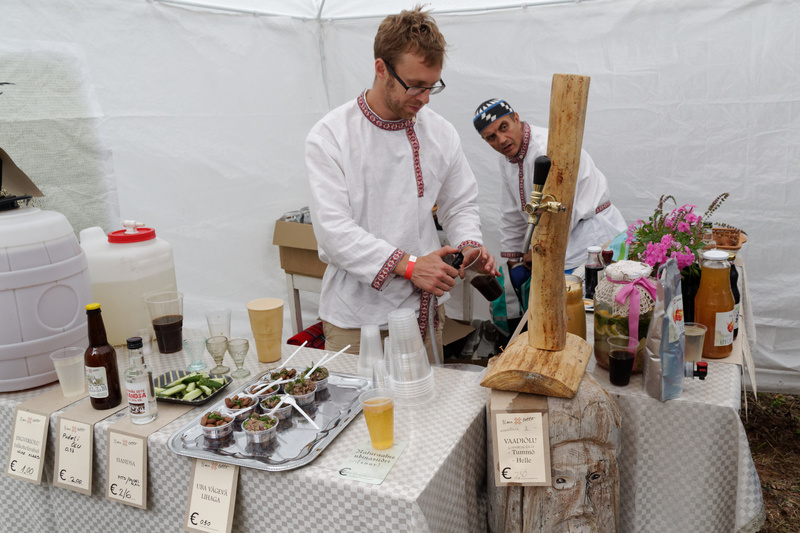
The guy with the "roasty" beer, from the farm Uma-tettü |
Then, suddenly, one beer was a little different. It was roastier and sharper in flavour than the others. We had no idea why, and language differences and busy brewers were making it difficult to learn very much about how these beers were made. We were collecting phone numbers and trying to make appointments to visit some of these brewers the next day to see what we could learn.
Then Amund found one beer that was pale yellow and acidic. It clearly had protein in it from malts, but there was more than just malts in it. Probably some ginger. Amund tried to quiz the brewer a little, at which point this conversation occurred:
Amund: Is there honey in this?
Brewer: Huh?
Amund: Honey?
Brewer: Honey!
Amund: Ah, honey.
Brewer: nods.
Drunk guy in queue: Hefeweizen!
Amund: There is wheat in it?
Drunk guy: Yes!
Amund: I thought people here used rye?
Drunk guy: Yes!
Amund: Where do they get the wheat?
Drunk guy: Yes!
Amund: You're just saying yes to everything, aren't you?
Drunk guy: Yes!
So we never really made a lot of progress on that one. Maybe it was a kind of honey kvass from wheat bread. Or a honey beer. Or something completely different. It was nice, though.
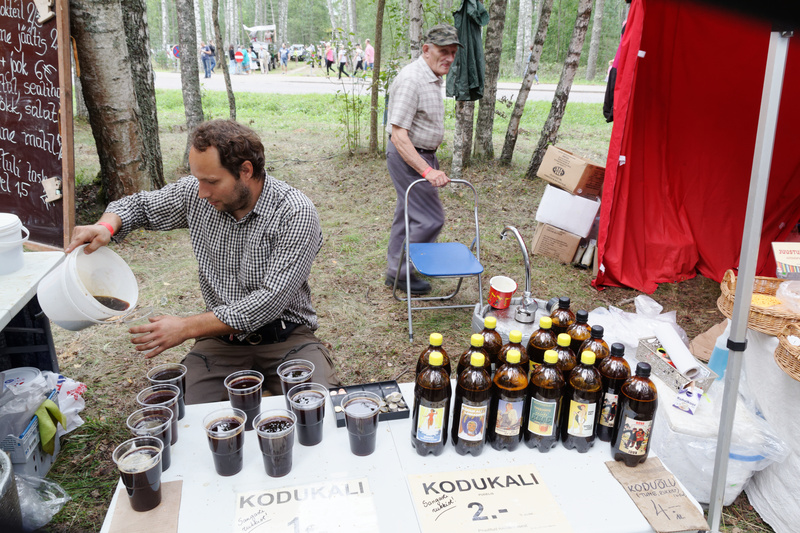
Man serving both "kodukali" and "koduõlu" |
Eventually we managed to put together some kind of picture of what was going on. Most of the brewers were using a kind of bread baked from rye flour together with sugar to make their beer. And they bought the bread in the shop, which was why their beers were so similar. The yeast was baking yeast. The beer that was more roasty used twice as much bread as the others, which explained the difference. Some of the brewers apparently added juniper berries, but the flavour was never very prominent.
We tried asking people about this mystery bread, which they call õlleleib (beer bread) and whether it was made from malts or flour, but people seemed not to understand the question. It's definitely a special "bread" for brewing. I asked several people if you could eat the bread and they said no. One person said it was "too bitter" to eat. Since they add sugar there probably isn't that much sugar coming from the bread, whatever it's made from.
The pale mystery beer we never managed to learn anything more about.
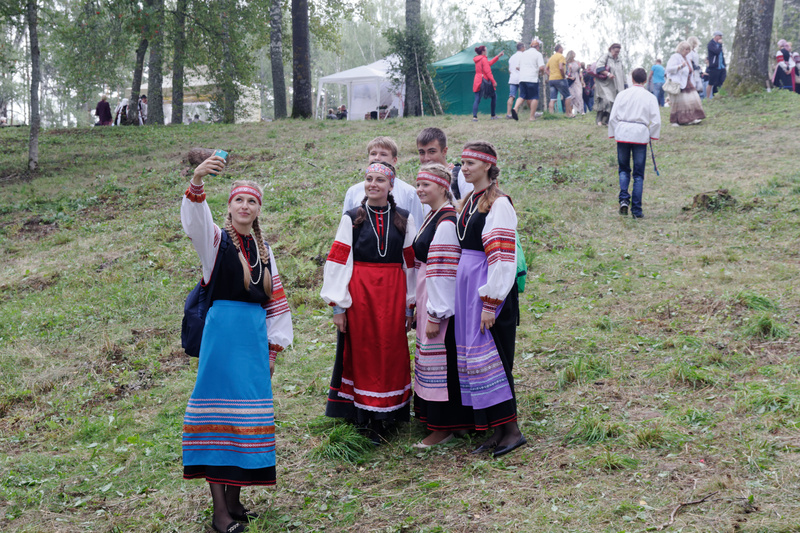
Seto girls taking a selfie |
One of the brewers explained that he made his beer sweet for the festival, because while he could sell dry beer to the men, some woman would be bound to complain. She would say that his beer was too dry, and therefore it must be too strong, and so he wouldn't be able to sell to any of the women. People at the festival all seemed to agree that the beer starts out sweet and weak and then later becomes dry and strong.
We found a second pale, acidic beer. This one had a kind of orange juice and apricot juice flavour. My Lithuanian friend Martynas thought this was a wheat bread kvass, and I'm sure he's right. I tried talking to the brewer, but again he just said yes to everything. I really would have liked to know how this was made, because it was a really, really good beer.
Then the parade started. This was a huge affair with lots of old vintage trucks, one of them turned into a mobile sauna, marching bands, people on horses, people on bicycles decorated to look like horses, and lots of painfully loud explosions. Everyone was laughing and having a good time.
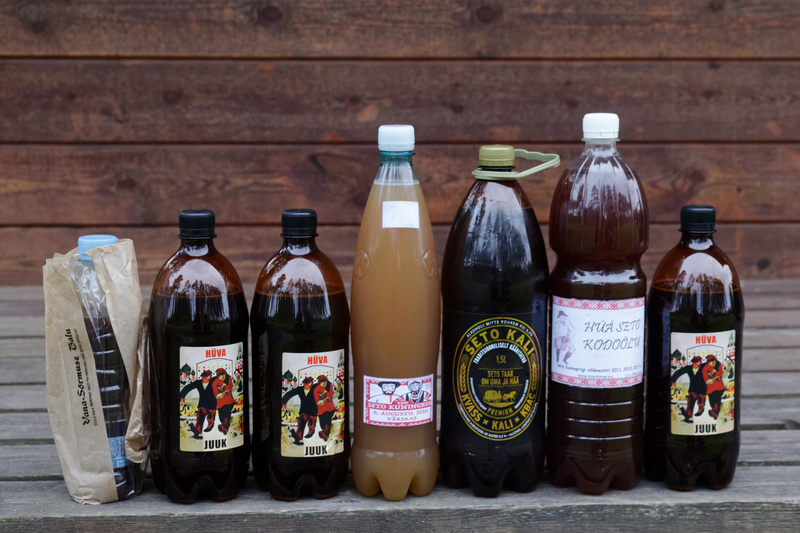
Our collection of beers |
Eventually, we went back to our camping cabins for the night. From what we learned at the festival it's clear that the Seto really have a distinct style of beer. They call it "koduõlu", which is the same word the Estonians on the islands in the Baltic use for their beer, which is very different. So we've taken to calling this oven-baked rye bread beer Seto koduõlu.
This method of making beer by baking the malts into a "bread" and then mashing with that was common in all of eastern Estonia, so this was not something that was practiced by the Seto only. Whether people other than the Seto are still making this type of beer I don't know. We didn't manage to find any, but that doesn't mean they're not there. For now, we're calling this "Seto koduõlu," but it may be it should really be called "eastern koduõlu".
And, of course, there has to be a link between Seto koduõlu and the Lithuanian keptinis, but it was only this year (2017) that I figured out what it was. We'll return to that when the blog is finished with 2016. Before that I have a lot more on Estonia.
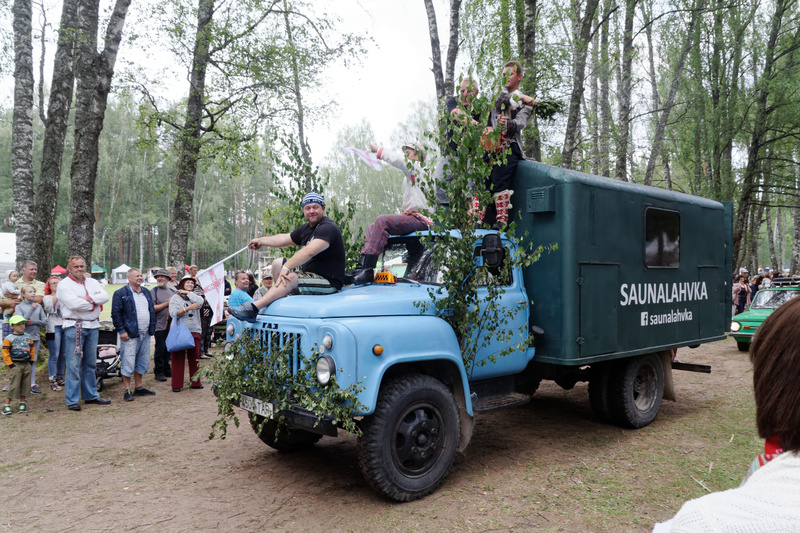
Sauna truck, from the parade |
Similar posts
Taarka Tarõ: A Seto restaurant
From the festival in Värska we drove on lonely forest roads to Obinitsa
Read | 2017-11-12 11:32
The great stove
As I wrote in the previous blog post, keptinis is a unique style of beer from north-eastern Lithuania where the mash is baked in an oven
Read | 2018-07-25 18:22
Pihtla, a farmhouse brewery on Saaremaa
Koduõlu is one of the few farmhouse styles that you can actually buy right now, thanks to the commercial brewery Pihtla Õlleköök, in the village of Pihtla on Saaremaa island in Estonia
Read | 2018-02-13 16:02
Comments
Kyle - 2017-11-06 16:47:38
Intresting. Do you have any indication on how this bread is made? Is the grain simply crushed or milled into a flour? Is it levened? And how does the baking effect the enzymes required for conversion? I fully understand that you were limited by language and consequently may not have answers. I also admit that some research on kvass would most likely answer many of these questions. But, as most post on this site do, it has sparked a good deal of interest in the topic and a motivation to experiment. Iím about to brew the raw ale recipe you so perfectly condensed on themadfermentationist.com. I would have made it sooner but finding a juniper tree on public land in the Chicago area took months of, rather pleasant, bike rides.
Lars Marius Garshol - 2017-11-07 07:59:16
@Kyle: Yes, we'll come to this "bread" in more details in the next blog post. It's definitely not leavened. It's not really bread. I think the baking kills most of the enzymes.
And note that this is not kvass. Kvass is something completely different. Kvass was basically a way to make safe drinking water from suitable kitchen leftovers. It didn't need to involve bread, but when it did the bread was real bread and not this oven-baked mash thing. Kvass is also basically non-alcoholic, or next to it.